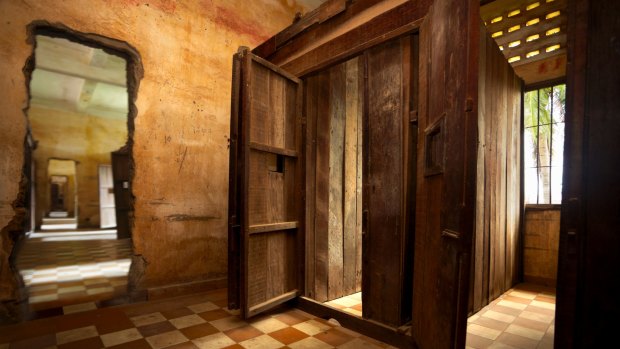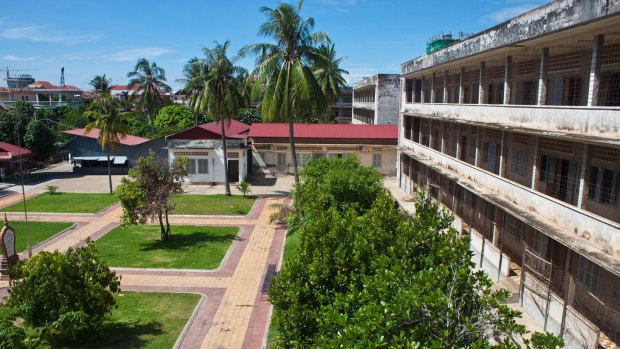This was published 9 years ago
The Genocide Museum, S-21: Cambodia's chilling house of terror, and why you must visit
By Lee Tulloch

Inside S-21, there are small cells the size of outdoor dunnies.Credit: iStock
In Phnom Penh, the capital of Cambodia, there is a museum devoted to the terrible genocide of 1975-79. The Tuol Sleng Genocide Museum is also known as S-21, the name of the jail where 14,000 people were imprisoned and tortured during the reign of the Khmer Rouge. Only seven people survived.
It was the first place I wanted to go when I arrived in the city. I was travelling with a group doing Cambodia in style with private guides, staying in luxury hotels and shopping up big. However, I and others in my group felt very strongly that it was wrong to enjoy the many pleasures of this beautiful nation without acknowledging the collective horror the people had been through in fairly recent times and the 343 "killing fields" where more than 2 million civilians were massacred by Pol Pot's regime.
I feel the same in most places I visit. It may seem gruesome to head immediately for cemeteries or museums such as Budapest's House of Terror or Dachau in Bavaria, but I believe that if you want to touch more than the surface of a place you need to understand something of its history, especially the least glorious moments. S-21 in Phnom Penh is confronting, but it's as important for visitors as the serene temples of the ancient Angkor civilisation. It would be disrespectful to ignore it.
S-21 consists of four concrete cell blocks of three levels around a courtyard now filled with mango trees and a memorial. It was one of 167 similar prisons set up by the Khmer Rouge. Prisoners were detained and tortured before being sent to one of the killing fields for execution. The prison remains as it was at that time, sparsely furnished except for the iron beds and manacles to which the prisoners were continually chained, the only other objects being the metal boxes they used as toilets and occasionally a hard chair and wooden table where the transcribers sat to take their confessions.
In other blocks, the prisoners weren't so "lucky" - they were restrained in small cells the size of outdoor dunnies. There was barely any food - they subsisted by eating bugs and cockroaches. One of the survivors was a painter. The guards liked his portrait of Pol Pot so he was allowed to live. His crude paintings of the heinous kinds of torture employed, painted after liberation, make the unimaginable imaginable.
The prison guards documented all the poor souls who were kept in S-21 by numbering them and taking their photos, and the rooms are filled with haunting displays of the faces of people who were tortured there. The photographs are the most powerful way of remembering the innocent people who suffered so horribly there.

The Khmer Rouge's victims line the walls of Tuol Sleng Genocide Museum, in Cambodia. Credit: Getty Images
Our guide, Channak, was separated from his family at six and sent to a children's camp in the countryside, where they were forced into manual labour, beaten and starved. His father, who had gained a university education, but was raised on a farm, managed to convince the Khmer Rouge he was uneducated, so he escaped prison and was sent to work in agriculture. His mother was separated from his father. Unusually, they all survived, although Channak says if the regime had lasted six months longer, he would have starved to death.
After liberation, Channak walked to his village. There was no one there but he was told to wait. A few days later his mother came crawling through the dust towards him. She was so thin and beaten he didn't recognise her.
Channak, now 42, comes to the prison several days a week with tourists. When we ask him how he can bear to confront the horror, he tells us he had nightmares for the first 10 years of being a tour guide. But he wants to bear witness and share his experiences, so that it never happens again.

Outside S-21, a courtyard is now filled with mango trees and a memorial.Credit: iStock
I don't say that it probably will happen again, hopefully not in Cambodia, as it has happened many times before, and is happening again somewhere in the world right now.
But Channak's beautiful spirit has survived, as has that of Mr Chum Mey, one of two last survivors who comes each day to sell his book inside the prison grounds. Cambodia is a miracle, in that the country has come so far and the people seem so forgiving only 36 years after the Civil War. But perhaps they have not quite healed yet.
Lee Tulloch was a guest of Abercrombie & Kent.
Sign up for the Traveller Deals newsletter
Get exclusive travel deals delivered straight to your inbox. Sign up now.